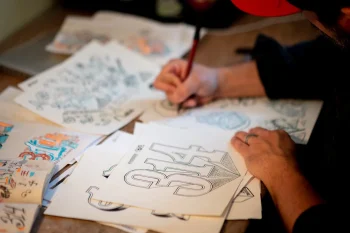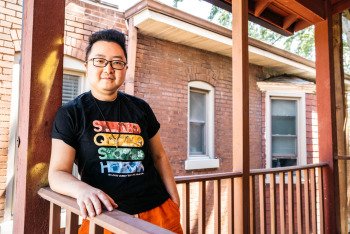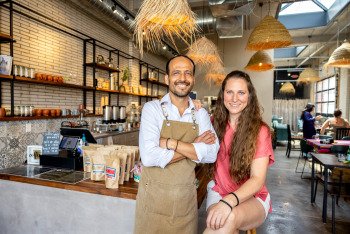Art in Motion
Through the Justice Fleet, Amber Johnson empowers people to heal.
The sunlight that streams into Dr. Amber Johnson’s office at Saint Louis University shines on mostly ordinary things: a tidy desk near the large window at the far end of the room, several fully stocked bookshelves, a display of glossy awards and certificates, a mustard yellow couch…
And there’s one more thing — a large inflatable pool filled with hollow plastic balls of every color.
Yep, it’s a ball pit.
“Anything that is looked at as fun makes difficult conversations easier,” Johnson insists. “Like, if you get into that ball pit, you can say things that you might not be willing to say outside of the ball pit. It’s just something about playing that makes people feel comfortable.”
The Art of Play
Playfulness and a sense of safety are fundamental to Johnson’s work teaching intercultural communication and critical culture studies courses at SLU. For more than a decade, Johnson, who uses they/them pronouns, has worked with students in the classroom to explore and unpack identity, privilege and bias.
To help students process what can be emotional sessions, Johnson developed the Forgiveness Quilt, a collaborative arts activism project that invites participants to paint their bias, ask for forgiveness and create positive affirmations about healing and letting go. The project resonated with students, who insisted that Johnson find a way to bring the project to more people in St. Louis and beyond.
Thus, the Justice Fleet was born. After speaking with colleagues about how to take empowering art activities on the road, Johnson secured an old delivery truck through SLU and began transforming it into a carrier for healing.
“They [SLU] have been incredibly supportive. This is the only institution that’s supported me to this level. When I originally went to them and said, ‘I want to take my classroom activities mobile,’ they gave me the truck. It took a while to get it, but they gave it to me,” Johnson says. “It looked like a hot mess. But then they gave me grants and I got some other grants to make it cool.”
A collection of mobile workshops and exhibitions designed to transform and empower communities through arts activism and playfulness, the Justice Fleet typically comes complete with paint, toys, Lego and, of course, a ball pit. The fleet travels throughout St. Louis and even to other areas of the country, serving as a resource both in neighborhoods that often are overlooked and museums where privileged curators are interested in making art more universally accessible. Johnson also frequently ends up in educational spaces and nonprofits, presenting Justice Fleet activities to people across a variety of ages, races and backgrounds.
Unpacking the weight that comes with exploring identity and trauma can be more difficult for adults than it is for children, Johnson finds. But eventually, there’s a breakthrough.
“We basically create an experience that allows adults to learn how to play again and imagine. We have these social injustice scenarios, like gender issues, racism, economic justice, food justice, environmentalism, education,” Johnson explains. “Essentially, we ask people to build the community that they would want to live in, that tackles these issues that are in this scenario.
“Usually in the first fifteen minutes, adults are just talking or trying to explain away the oppression,” Johnson continues. “Like, just stop talking and just build it. Once they get the hang of it, they build magical things.”
The Justice Fleet’s active exhibitions include Radical Forgiveness and Radical Imagination, with another two exhibitions in development. The popular Radical Imagination uses lighthearted laughter and a sense of play to encourage vulnerability and creativity, helping participants open themselves up to imagining a more equitable and just future.
“A group of six people might huddle around a box of toys, and what we’ve seen is that community members, if given the space, know what’s wrong, know how to fix it, and know how to assess it,” says Johnson. “It’s just a matter of giving them the space to do it.”
The ball pit is one example of this philosophy. With a wide range of open-ended questions taped to the side of the colorful plastic spheres, people are prompted to consider questions such as, “What is art?” Another ball asks, “How do you think the St. Louis Police Department can better serve and protect St. Louis residents?”
With balls serving as innocuous but deeply relevant conversation starters, the stage is set for meaningful dialogue.
“If you ask an activist or someone who is an educator, in terms of systemic oppression or social justice, ‘What world do you want to live in,’ usually there’s no answer. But if you ask them to explain all the things that’s wrong with the world, we could talk for years,” Johnson explains. “We’ve spent a lot of time deconstructing systems of power, but this is about what we want to build in its wake. Once we get rid of theses systemic issues, what do we want to experience? What do we want life to feel like, to be like and sound like?”
Johnson describes another developing exhibition, Transfuturism, as “the most museum-like exhibit” in the fleet. In it, Johnson photographs and interviews transgender and non-binary people and then paints large portraits of them as superheroes. Using Afrofuturism as a lens, this exhibit argues that trans and non-binary people are, in fact, ahead of their time, already living and embodying the very future that Afrofuturists speculate about.
A fourth exhibition, the Grief Garden, also is in the works and is intended to serve as a safe, nurturing space for people to grieve in community with each other. Johnson predicts the mobility of this exhibit will be especially useful, allowing their team to support families or communities after the death of a loved one in whatever location is most convenient and comfortable for them.
Using Vulnerability to Move Toward Healing
In the last year alone, Johnson’s work with The Justice Fleet has yielded a number of noteworthy ethnographic insights around intercultural communication and identity negotiation. For such heavy, unquestionably complicated topics, creating a playful atmosphere might seem counterintuitive. But, Johnson says, playfulness, laughter and creativity make room for vulnerability, and vulnerability plays a critical role in transformation.
“The system isn’t this mythical thing that’s out there—it’s fueled by humans. If we can get those humans to be vulnerable—that’s the hard part, because when you benefit from systemic power, why would you want to give up? It’s hard to give up,” Johnson says. “Getting people to understand that creating opportunities for others to seek and thrive in their own powers does not take away from your own power is the hardest lesson to teach people.”
In many ways, the protests in recent years in Ferguson and across St. Louis acted as the epicenter of what has since become a national conversation around racism, justice, and systemic inequity. But across the country, the questions, challenges, reactions, lessons and art that Johnson has witnessed to with The Justice Fleet share telling similarities that they find especially striking.
“Everywhere I go, it’s the same paintings, the same topics,” they say slowly, shaking their head slightly. “There’s a massive universal struggle for marginalized folks, and it might transpire differently but it has the same roots. It’s creepy. Rural communities, big cities, suburbs, same stuff. It’s rooted in your big -isms—gender, sexism, racism, economic injustice.”
It would be shortsighted to assume to assume that racism and the other “big -isms,” as Johnson says, are at all unique to St. Louis. But by that same logic, perhaps possible solutions could become just as widespread. Projects like the Justice Fleet attempt to build emotionally thoughtful, innovative pathways through vulnerability, learning and forgiveness, ultimately moving participants closer to their own healing. And to Johnson, the reality and necessity of healing is the biggest takeaway from the Justice Fleet’s work.
“Healing from trauma associated with oppression is just as important as crafting policies that combat oppression,” Johnson says. “We talk about equity all the time, but we don’t talk about healing enough. And those things have to happen at the same time.”



